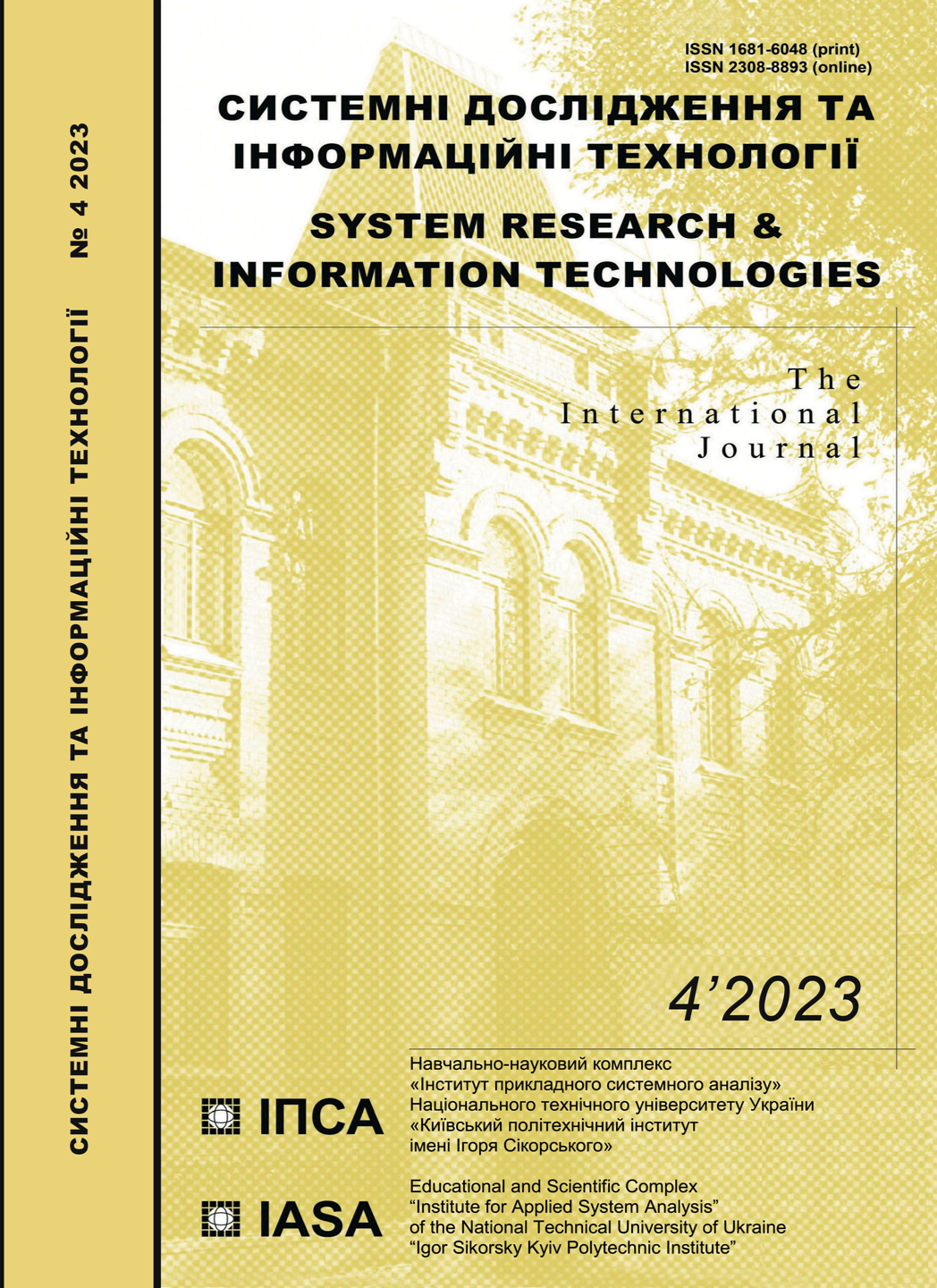Modeling cryptocurrency market dynamics using machine learning tools
DOI:
https://doi.org/10.20535/SRIT.2308-8893.2023.4.04Keywords:
ensemble models, machine learning, time series, cryptocurrencyAbstract
The article analyzes the dynamics of the cryptocurrency market (Bitcoin) using econometric estimation tools based on machine learning models. The forecasting method is improved based on time series decomposition and lagged shifts of financial indicators. An ensemble of short-term forecast models for the Bitcoin exchange rate is built, and its accuracy is analyzed and compared to individual component models. Time series models are used along with calculated financial indicators (ADODS, NATR, TRANGE, ATR, OBV, RSI, ADTV). The absolute deviation of the short-term forecast amounted to $9.5, which is 0.06% of the absolute value.
References
Gandhi Pratik, 7 Statistical Tests to validate and help to fit ARIMA model. Available: https://towardsdatascience.com/7-statistical-tests-to-validate-and-help-to-fit-arima-model-33c5853e2e93
Kotzé Kevin, Vector autoregression models. Available: https://kevinkotze.github.io/ts-7-var/.
Taiwo Oladipupo Ayodele, Types of Machine Learning P.19-28. Algorithms. Available: https://cdn.intechopen.com/pdfs/10694/InTech-Types_of_machine_learning_algorithms.pdf
Onchiri Sureiman and Callen Moraa Mangera, “F-test of overall significance in regression analysis simplified,” Journal of the Practice of Cardiovascular Sciences, vol. 6, issue 2, pp. 116–122, May-August 2020. doi: 10.4103/jpcs.jpcs_18_20.
Sander Greenland et al., “Statistical Tests, P-values, Confidence Intervals, and Power: A Guide to Misinterpretations,” The American Statistician, Online Supplement, pp. 1–12, 2016. Available: https://events.gwdg.de/event/482/attachments/391/580/anwer_to_the_ASA_statement_misinterpretations.pdf
L. Brown, “The conditional level of Student’s – test,” The Annals of Mathematical Statistics, vol. 38, no. 4, pp. 1068–1071, Aug., 1967. Available: https://faculty.wharton.upenn.edu/wp-content/uploads/2012/04/Conditional-level-of-students-t-test.pdf
Xiaojun Song and Abderrahim Taamouti, “A better understanding of Granger causality analysis: A big data environment,” Oxford Bulletin of Economics & Statistics, pp. 2–25, August 2019. Available: https://www.researchgate.net/publication/329803300_A_Better_Understanding_of_Granger_Causality_Analysis_A_Big_Data_Environment
Champion Robert and Mills M. Terence, “Demonstrating the Durbin-Watson Statistic,” Journal of the Royal Statistical Society Series D (The Statistician), 47(4), pp. 643–644, December 1998. doi: 10.1111/1467-9884.00161.
G. Gurupradeep, M. Harishvaran, and K. Amsavalli, “Cryptocurrency Price Prediction using Machine Learning, 2023,” International Journal of Advanced Research in Computer and Communication Engineering, vol. 12, issue 4, pp. 808–814, April 2023. doi: 10.17148/IJARCCE.2023.124140.
L.O. Kibalnyk, O.A. Kovtun, and G.B. Danylchuk, “Modeling and analysis of the current state of the cryptocurrency market,” Economics and management in the period of digital transformation of business, society and the state: materials of the Jubilee International Scientific and Practical Conference (May 28–29, 2020, Zaporizhzhia). Zaporizhzhia: ZNU Engineering Institute, 2020, pp. 112–117.
Leopoldo Catania and Stefano Grassi, “Modelling Crypto–Currencies Financial Time–Series,” SSRN Electronic Journal, pp. 2–38, August 2017. doi: 10.2139/ssrn.3028486.
George E.P. Box, Time series analysis: forecasting and control; fifth edition, 2016, 668 p. Available: http://repo.darmajaya.ac.id/4781/1/Time%20Series%20Analysis_%20Forecasting%20and%20Control%20%28%20PDFDrive%20%29.pdf
Andrea Majdáková, Blanka Giertliová, and Iveta Hajdúchová, “Prediction by financial and economic analysis in the conditions of forest enterprises,” Journal of Forest Science, 66, 2020 (1), pp. 1–8. Available: https://www.agriculturejournals.cz/pdfs/jfs/2020/01/01.pdf
Chaikin A/D Oscillator. Available: https://www.cryptohopper.com/resources/technical-indicators/283-chaikin-a-d-oscillator.
Normalized Average True Range. Available: https://taapi.io/indicators/normalized-average-true-range/
Average True Range. Available: https://www.fidelity.com/learning-center/trading-investing/technical-analysis/technical-indicator-guide/atr.
Average True Range. Available: https://www.wallstreetmojo.com/average-true-range/
William Wai Him Tsang and Terence Tai Leung Chong, “Profitability of the On-Balance Volume Indicator,” Economics Bulletin, 29(3), pp. 2424–2431, January 2009.
Average Rate Of Return: Meaning, How To Calculate And Uses. Available: https://in.indeed.com/career-advice/career-development/average-rate-of-retur
Kramar Vadim and Alchakov Vasiliy, “Time-Series Forecasting of Seasonal Data Using Machine Learning Methods,” Algorithms, vol. 16, issue 5, pp. 2–16, 2023. doi: 10.3390/a16050248.
Andrius Buteikis, Time series with trend and seasonality components. 66 p. Available: http://web.vu.lt/mif/a.buteikis/wp-content/uploads/2019/02/Lecture_03.pdf
Harding Ben and Clayton V. Deutsch, Trend Modeling and Modeling with a Trend. May 12, 2021, 14 p. Available: https://geostatisticslessons.com/lessons/trendmodeling
R. Shumway and D. Stoffer, Time series analyses and its applications; 3rd ed. 2011, 576 p. Available: http://pzs.dstu.dp.ua/DataMining/times/bibl/TimeSeries.pdf
Hariaji Joko, Simple Linear Regression (SLR) Model and Multiple Linear Regression (MLR) Model, May 2021, pp. 1–34. doi:10.13140/RG.2.2.17237.35044.
Qiang Sun and Wenxin Zhou, “Adaptive Huber Regression,” Journal of the American Statistical Association. October 2018, 56 p. doi: 10.1080/01621459. 2018.154312. https://www.researchgate.net/publication/317732614_Adaptive_Huber_Regression
Dastres Roza and Soori Mohsen, “Artificial Neural Network Systems,” International Journal of Imaging and Robotics, 21(2), pp. 13–25, March 2021. Available: https://www.researchgate.net/publication/350486076_Artificial_Neural_Network_Systems

